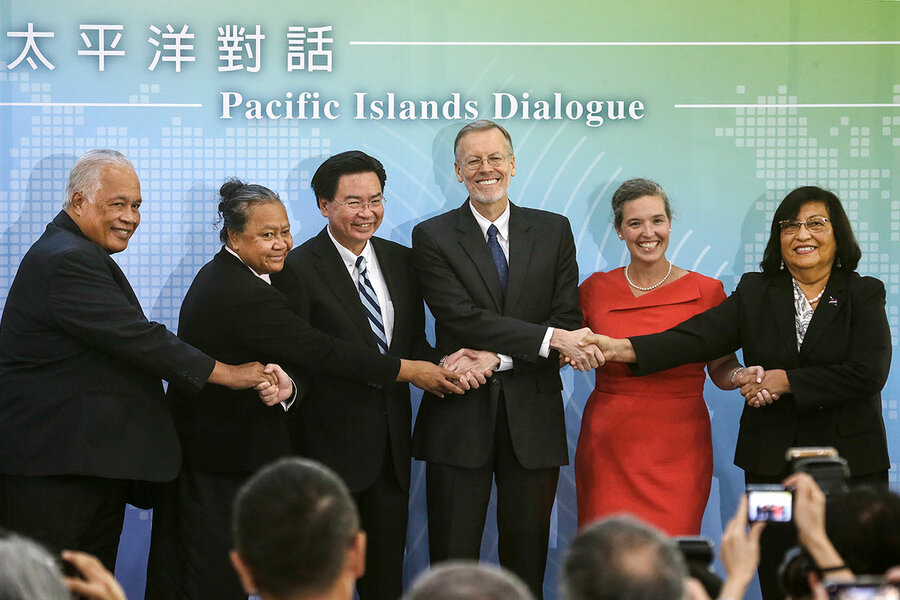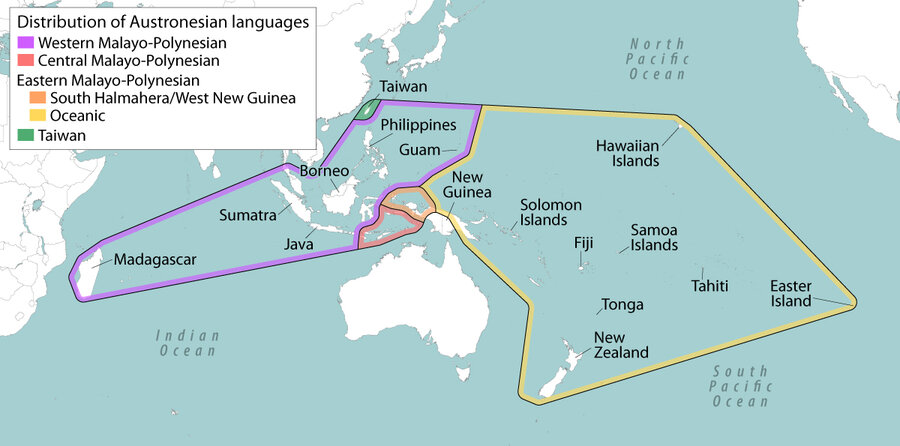
Ulung Lupiliyan remembers his 2018 trip to Tahiti fondly – he spent 20 days hopping between islands and meeting other Indigenous families like his own back in Taiwan.
But it wasn’t just personal interest that brought the graduate student overseas. The Taiwanese government helped pay for Mr. Lupiliyan to visit French Polynesia as part of a broader strategy to maintain the country’s presence on the international stage.
Why We Wrote This
How does diplomatically pinched Taiwan maintain a presence on the world stage? In a creative but somewhat controversial strategy, the island has leaned on Indigenous communities.
As China’s economic and political clout grows, Taiwan’s dwindles, and all but 15 countries have cut ties with the island in recent decades. Indigenous communities act as an international relations lifeline; they are Taiwan’s sole representatives to the United Nations, and last month, Taiwan made headlines as a founding member of the Indigenous Peoples Economic and Trade Cooperation Agreement. Government-sponsored cultural exchanges have also helped expand and cement Taiwan’s influence in the Pacific.
Critics worry Taiwan is exploiting Indigenous communities, but others say this diplomatic strategy is an opportunity for all Taiwanese to reconnect with the island’s history.
“Taiwanese society has a unique phenomena: It isn’t sure exactly where its roots lie,” says Yapasuyongu Poiconu, from Taiwan’s Council of Indigenous People. “Indigenous diplomacy … is a form of soft diplomacy that’s built on a personal foundation with other people, a way of fostering mutual understanding.”
Taipei, Taiwan
Ulung Lupiliyan remembers feeling nervous as he stood in front of a classroom, more than 6,600 miles away from home, preparing to give a lecture to about 40 students at the University of French Polynesia on the island of Tahiti. It was Fall of 2018, and he was nearing the end of a 20-day trip spent hopping from one tropical island to another, visiting Indigenous communities, cultural centers, and even a tattoo festival.
As he started presenting on contemporary Indigenous issues in Taiwan, Mr. Lupiliyan’s anxiety dissipated. The students were curious about him and his people, and shocked by similarities between their languages.
Mr. Lupiliyan left the classroom feeling more connected to Polynesian people and culture, but it wasn’t just personal interest that brought the graduate student to Tahiti. Taiwan’s government helped pay for Mr. Lupiliyan and 11 other members of the Paiwan people to travel to French Polynesia as part of a broader strategy to maintain the country’s presence on the international stage.
Why We Wrote This
How does diplomatically pinched Taiwan maintain a presence on the world stage? In a creative but somewhat controversial strategy, the island has leaned on Indigenous communities.
Taiwan’s 1971 expulsion from the United Nations ushered in a new era of increasing diplomatic isolation, and all but 15 countries have cut ties with the island as China’s economic and political clout has grown, threatening Taiwan’s autonomy. Meanwhile, Indigenous communities have become an international relations lifeline; they are Taiwan’s sole representatives to the UN, and last month, Taiwan made headlines as a founding member of the Indigenous Peoples Economic and Trade Cooperation Agreement, a first-of-its-kind multilateral trade deal that includes countries such as New Zealand and Canada. Cultural exchanges like Mr. Lupiliyan’s Tahiti trip also help expand and cement Taiwan’s influence in the Pacific region.
Critics worry the Republic of China – Taiwan’s formal name – is exploiting its Indigenous communities without necessarily improving their economic conditions or cultural welfare, but others say that Taiwan has been forced to lean on its Indigenous heritage for the security of all the island’s residents.
“Taiwanese society has a unique phenomena: It isn’t sure exactly where its roots lie,” says Yapasuyongu Poiconu, member of the Tsou people and head of the Comprehensive Planning Department at Taiwan’s Council of Indigenous People (CIP), the highest Indigenous institution in the country. “Indigenous diplomacy isn’t traditional diplomatic activity. It’s a form of soft diplomacy that’s built on a personal foundation with other people, a way of fostering mutual understanding.”
Finding Taiwan’s Roots
While the majority of Taiwanese people descend from Han Chinese settlers that began coming to the island in the 17th century, people had been living in Taiwan for thousands of years prior. Their descendants make up nearly 3% of the island’s current population, about half a million people. There are 16 Indigenous groups recognized by the government, with the largest being the Amis, the Atayal, and the Paiwan.
Indigenous communities were largely left out of Taiwan’s rapid economic development during the 1980s and ’90s, and today, surveys show Indigenous people are more likely to live in poverty and less likely to receive a higher education. In 2020, the average gainfully employed Indigenous person made 75% of the monthly wages of their non-Indigenous counterparts, according to a CIP report.
The cultural picture is arguably as stark. UNESCO classifies at least five of Taiwan’s 16 Indigenous languages as critically or severely endangered, with the rest described as vulnerable. This is the result of specific assimilationist policies carried out by first the Japanese and then the Chinese Nationalist Party, including suppression of Indigenous languages, restrictions on traditional ceremonies and rituals, and the encouragement of migrations to urban areas far from their traditional lands.
An Indigenous economic and social justice movement emerged in the 1990s, as Taiwan democratized and began distancing itself from mainland China, setting the stage for greater Indigenous participation in state affairs. According to Mr. Poiconu, this shift also coincided with the growing salience of Indigenous issues around the world.
At the same time, linguist Robert Blust’s “Out of Taiwan” theory – that Taiwan was the source of all Austronesian languages stretching from Madagascar to Hawaii – was becoming popular. Huang Shu-mei, a professor at National Taiwan University in Taipei who studies Indigenous heritage, says this idea “reoriented Taiwan’s imagined geography,” converting it from a society rooted in Chinese colonization to one embedded in the greater Pacific. The concept of a connected, Austronesian people has since become the bedrock of Taiwan’s Indigenous diplomacy efforts. From 2002 to 2007 the CIP organized the Assembly of Austronesian Leaders, and in 2016 the administration of President Tsai Ing-wen established the permanent Austronesian Forum. They’ve also invested in economic development and cultural exchange programs throughout the South Pacific.
However, it’s unclear if that Austronesian identity really exists beyond Taiwan. Officials and exchange participants from other supposedly Austronesian nations are often unaware of what the term means, and don’t necessarily see themselves even as “Indigenous,” says Professor Huang.
“There’s a tendency to extend linguistic connections to other types of connections,” she says, adding that the Taiwanese “government has been more than happy to go along with this misunderstanding because it can make its policies more successful.”
What is clear is that Austronesian diplomacy has become entrenched in Taiwan, and the state benefits by using Taiwan’s unique heritage to secure its position in the region. But some argue these efforts have little impact on the island’s Indigenous communities.
A win-win strategy?
“I haven’t seen much development in Indigenous industry or trade,” says Daniel Davies, a Ph.D. candidate researching multiculturalism and Indigenous representation at National Sun Yat-sen University in Kaohsiung, Taiwan. Given the inequalities in Taiwan’s labor force, Mr. Davies argues that Indigenous families are less likely to directly benefit from international trade agreements like the IPETCA. “They don’t have the luxury of thinking about these things,” he says.
Another inherent tension in Austronesian diplomacy is the contradiction between using Indigenous identity to strengthen a state that has yet to undergo decolonization.
“Today’s government is still a colonial government,” says Mr. Lupiliyan, the Paiwan man who’s participated in several exchange activities sponsored by the government. “It’s also true to an extent that the government is using the colonized to protect its international position.”
But he still believes the main beneficiaries are Taiwan’s Indigenous people.
Assimilationist policies caused many traditional ceremonies and art forms to disappear in Taiwan. Austronesian diplomacy offers all Taiwanese a way of reconnecting to the island’s history, and exchanges allow Indigenous people to learn from cultures related to their own. “When we go abroad, these countries and their cultural activities provide a blueprint for our own cultural revitalization,” he says.
Still, not all cultural exchanges are created equal – Mr. Lupiliyan had been on several government-backed trips before the 2018 exchange in Tahiti, but says that one was unique because it was planned entirely by the Indigenous participants, all young Paiwanese people from the Taimali Creek area in southeastern Taiwan. He says this experience helped him realize Indigenous people can use Austronesian diplomacy, rather than the state, to represent their communities, and “that we could hold more autonomy on a local, community level.”
Done well, he says Austronesian diplomacy can offer a window into what it could look like to live in a society where Taiwan’s Indigenous people have been “mainstreamed,” and are no longer a minority on the margins.

